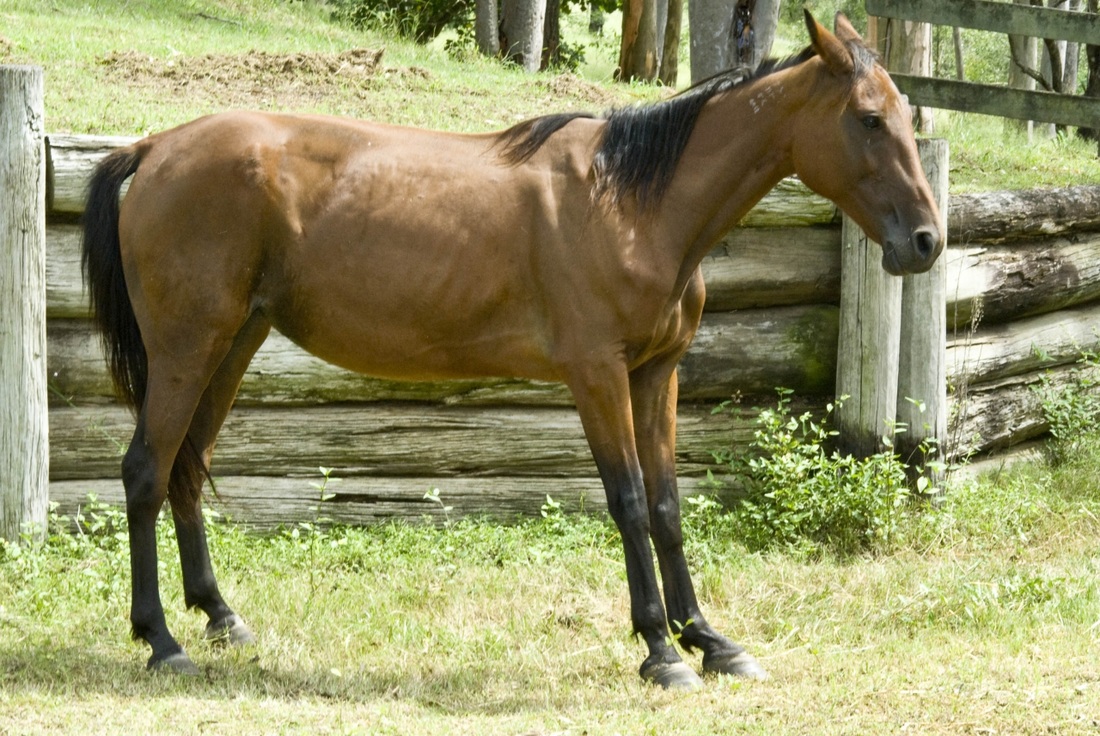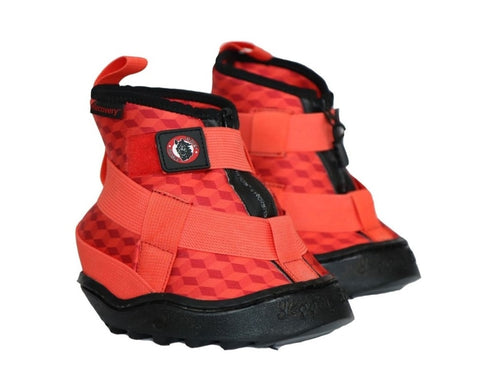Laminitis Rehab - All Brands on Deck
First Visit

She had size Reg 2 Scoot Boots (Brand # 1 in our story) on front, but with no pads I could tell she was still very sore. Her owner said she was a lot better in the boots, but still, she could barely hobble around her stall and had been laying down a lot. Scoots have the perfect amount of protection from concussion for a horse that is riding on rocks , but a severely laminitic horse really needs rehab boots because you can add thick cushy pads. So we decided to put Equine Fusion Recovery Boots (brand # 2 to the rescue) with thick pads on the front and move the Scoot Boots to the back feet.


Scoot Boots in black and Equine Fusion Recovery Boots in red
When we removed the Scoot Boots we stood the horse's front feet on the two neoprene blocks so that she would have some padding to stand on while I picked up one foot to put the Recovery Boot on the other foot. I didn't catch it all on video but she was rocking side to side shifting her weight and seemed to be either testing the feel of the blocks or relieving pain by alternating weight from one foot to another.
The the neoprene, being 3/4" of cushiness seemed to help her, and I didn't have any thick boot pads on me so decided to cut the blocks into pads for the front feet.

Scoot Pads 3mm thick
Re-Padding
While the DIY pads made of neoprene worked well at first, within 3 days they squashed completely flat and useless. My client went to the local tack store and all they had were (welcome Brand #3) these EasyCare wedge pads.

The round part of the pad is the back but they fit better in the Recovery boots backwards. They were too thick, a little too long, and we didn't want a wedge. So I took the pad home and McGyver (I mean my husband) ran them through the bandsaw so they are all one thickness and fit nicely into the toe of the boot.

If you look closely you can see where the pad was cut horizontally with the bandsaw and also where I cut the heels a little narrower and shorter with scissors. The pads are now the same uniform thickness and fit much better into the boots. They should last longer than our makeshift pads!
As a side note the owner is proactively treating the horse for thrush as there can be an added risk of that being booted 24/7, especially with rehab boots that are a less breatheable, and cushy pads that are constantly against the sole. But it's a good trade-off for the amount of comfort that is offered.
Vet Visit
He said some horses will have terrible x-rays and not exhibit much pain, while others can have pretty good x-rays and seem worse. This horse sort of illustrated that concept because she seems more sore on the right front (if we pick up the left foot she almost buckles even if standing on a pad on the left), but the x-ray was worse on the left!
This horse is normally shod, and has shoes pulled for winter so was barefoot when this happened, but the tentative plan is to put the horse back in shoes
I did mention to the owner that it would be good to make sure the farrier does something to support the center of the hoof to keep the coffin bone from sinking further if only the perimeter of the hoof is supported. I am hoping to be there for the farrier visit.
The Future
Product wrap-up
- Equine Fusion Recovery Boots (on front): https://timberlinetack.com/products/equine-fusion-recovery-shoe?variant=41688340791494
- Scoot Boots (on back): https://timberlinetack.com/collections/scoot-boots-accessories/products/scoot-boot-pair
- Scoot Boot Pads (on back): https://timberlinetack.com/collections/scoot-boots-accessories/products/scoot-pad-pair
- Easyboot Cloud Pads (on front- cut flat on our own): https://www.bigdweb.com/product/code/SBECLD-SP.do?gclid=CjwKCAjw8sCRBhA6EiwA6_IF4cMDF3FxDYRPcDvfWXbfAEg5JqUVOO7-779Wc8gRa6GMO3Xq3BaiORoC7S0QAvD_BwE
- Once the cloud pads wear out, if the horse is feeling better by then we may switch to Equine Fusion Pads in the front boots: https://timberlinetack.com/collections/equine-fusion-hoof-boots/products/equine-fusion-dampening-pads
Join our Facebook group for tips, tricks, fun stuff, and to follow stories like this one! https://www.facebook.com/groups/191421184909626
